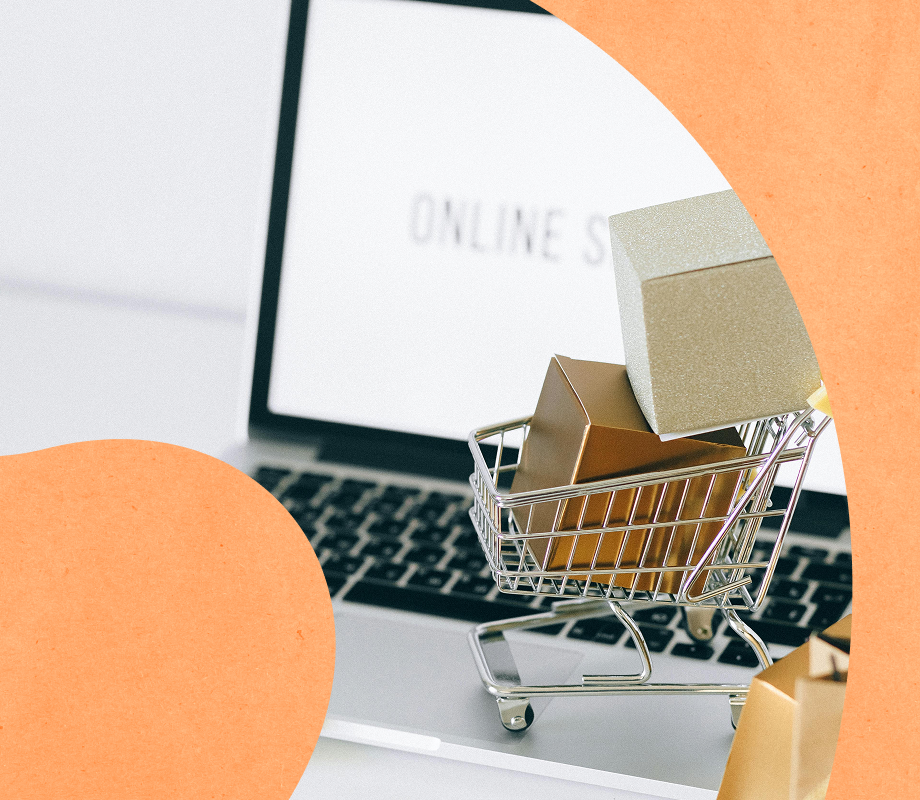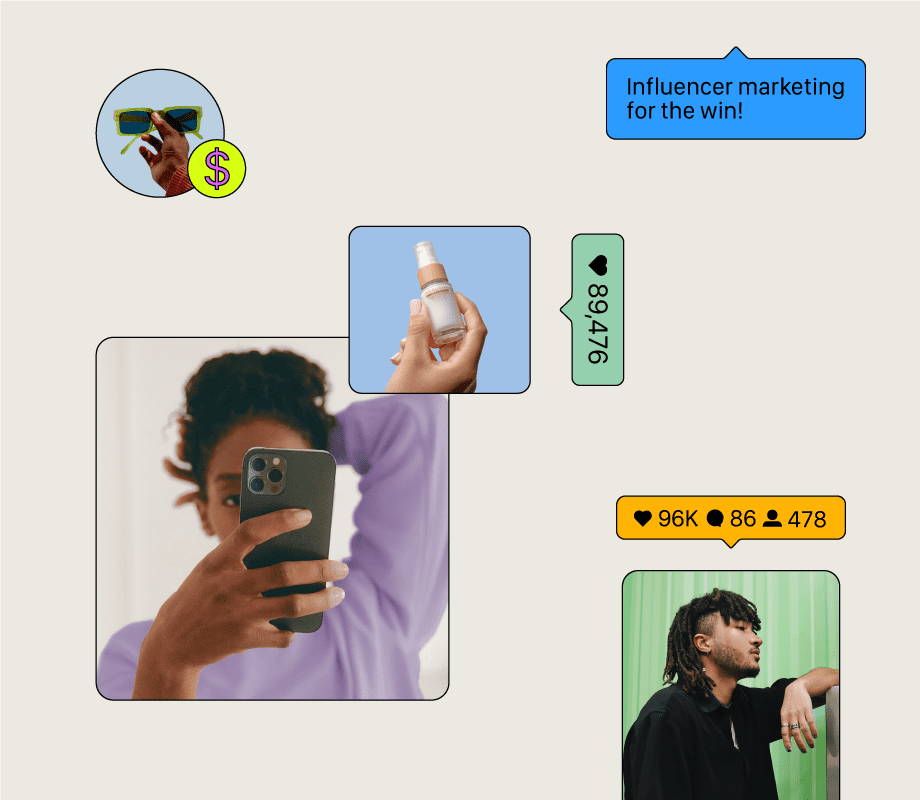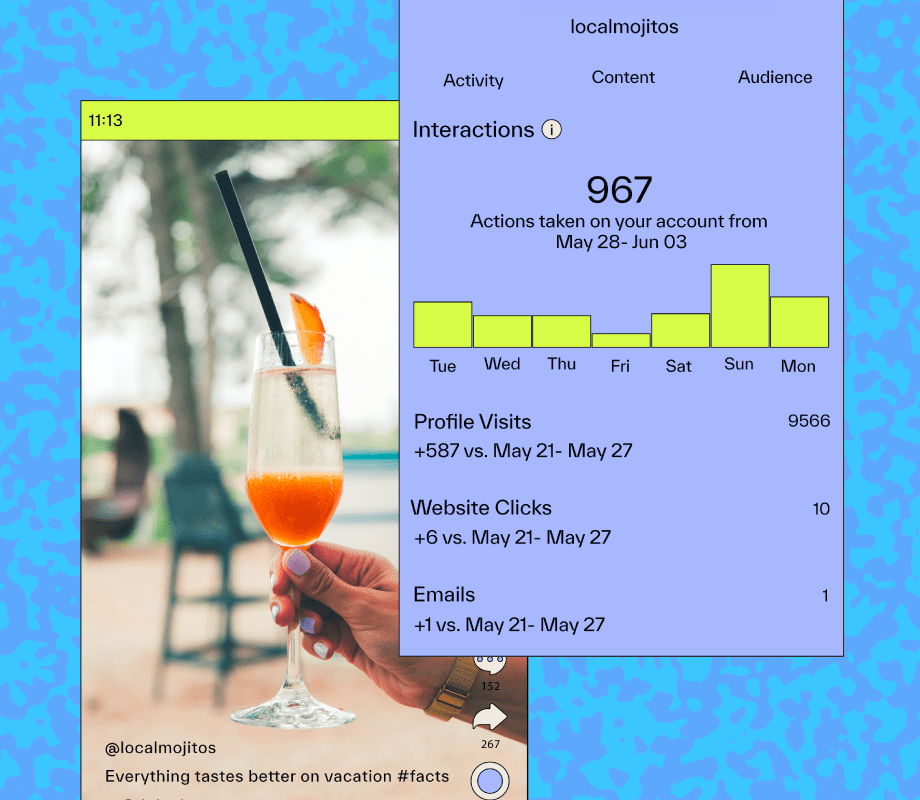Influencer marketing is one of the most effective ways to drive ecommerce growth—but between emerging platforms, shifting consumer trust, and the sheer volume of creators, it can be tough to know where to begin.
From buzzword definitions to real-world case studies, this guide to influencer marketing in ecommerce cuts through the jargon to what you need to know to get started on a successful, scalable social media marketing campaign.
Book a call with our team to see how Later can help you build smart, scalable influencer campaigns that actually move the needle.
Table of Contents
- What is influencer marketing?
- Importance of influencer marketing in ecommerce
- How to find ecommerce influencers
- Top influencer marketing channels
- Pros and cons of ecommerce influencer marketing
- How to set up winning influencer campaigns
- Examples of influencer marketing in ecommerce
- Role of influencer marketing in ecommerce
- Grow ecommerce revenue with influencer marketing
Join over 1 million marketers to get social news, trends, and tips right to your inbox!
Email AddressWhat is influencer marketing?
Influencer marketing is a collaboration between a brand and an individual (or organization) that seeks to leverage the knowledge and credibility of the individual into an authentic endorsement of the brand. In the social media age, with brands able to connect with creators who influence massive online audiences, it's one of the world's fastest-growing marketing segments—estimated to have tripled in market size (from around $10 billion to over $30 billion) between 2020 and 2025.
The core of influencer marketing is trust. Many people spend hours each day on social media platforms, from Facebook to Instagram to TikTok, making it easier than ever for effective content creators to reach large audiences. The creator-audience relationship is built on authenticity and niche alignment: People follow creators who know what they're talking about and believe in what they're doing in a specific niche.
If you want to leverage the power of influencer marketing for ecommerce, the trust between influencers and their followers is where real opportunity lies. People listen to influencers' recommendations more than impersonal advertisements or vague celebrity endorsements. When you partner with an influencer and they promote your product, you're tapping into a ready-made audience of people interested in your niche.
Not sure how to build your influencer network? Use the Later influencer marketing program to find, vet, recruit, and collaborate with creators from our community of over 10 million influencers. Our influencer marketing services make it easy to apply proven campaign strategies for influencer marketing in ecommerce.
Importance of influencer marketing in ecommerce
The secret is out. For several years now, everyone from the New York Times to Fortune magazine has reported that Gen Z increasingly turns to TikTok for information over traditional search engines like Google. This is a significant indicator of what marketers have long known: Social media influencers are becoming increasingly important for product discovery.
The explanation for this usually comes down to social proof, which is the idea that people are influenced by the opinions and experiences of others when making decisions (especially purchasing decisions). In a cluttered digital environment of unskippable ads and pop-ups, a trusted influencer offering authentic advice is a highly effective form of social proof.
How to find ecommerce influencers
Finding the right influencers to connect your brand to your target audience is a huge part of successful influencer marketing. The right creators should have solid follower counts, sure—but there are also important questions to answer about how well they align with your brand's values and the potential customers you're seeking. Later's influencer discovery tool helps you cut through the background noise of a crowded marketplace to find the creators who are best suited to your marketing plans.
Not sure where to start? Consider these three key points when looking for ecommerce influencers for your next marketing campaign:
1. Brand fit
A creator with millions of followers and incredible engagement isn't going to be of much help to your marketing if they make videos about antique woodworking and you sell makeup. Brand fit is a key element of influencer selection. It's important that the creators you work with are a good match for the tone and values of your brand, and that they're speaking to your target audience.
2. Engagement rate
Engagement rate is a social media marketing metric that measures how people interact with content. Typically, you calculate it by dividing the total number of views by the total number of interactions. On its own, engagement is a valuable indicator of a post's performance. Tools like Later's engagement rate calculator can help you get a better understanding of your engagement stats, set healthy benchmarks, and gather useful data such as industry average rates across a given social media platform.
Later's influencer analytics platform is a powerful collection of tools for campaign reporting and analytics. Book an analytics demo to see how Later helps you easily track real-time data for your social media marketing campaigns.
3. Previous sponsorships
Just like you'd review a resume of a potential job candidate, you can review an influencer's past work. Look at past sponsorships and performance in campaigns for other brands to assess influencer alignment with your brand and marketing ambitions.
Top influencer marketing channels
You have a wide range of online marketing channels to choose from, each offering distinct advantages.
The top influencer marketing channels include:
Instagram is optimized for high visual impact and is known for having great shoppability.
YouTube
While other platforms are more oriented toward short snippets, YouTube still rewards good storytelling with solid returns for long-form content. Search engine optimization pays off big time on this platform.
TikTok
TikTok is the platform of choice for Gen Z. The majority of users stick to the For You page and swipe through algorithmically selected clips, making the platform highly trend-based.
The stalwart social media platform has solid credibility with its community, not least because it is increasingly the preferred platform for niche communities, built around particular expertise or preferences.
Creators and brands routinely use multiple platforms to maximize content reach, but managing multiple campaigns and creators across multiple platforms can be a colossal task without the right tools. Later's campaign platform and content syndication tools let you manage every step of your social media marketing campaigns across multiple platforms.
Pros and cons of ecommerce influencer marketing
Of course, there are pros and cons to using influencer marketing for your ecommerce brand.
The cons are largely due to the complexity of managing a rapidly evolving set of interactive parts, including campaign tactics, influencer coordination, and posting on multiple platforms. Specific drawbacks include:
Manual scalability challenges:
As your influencer marketing program scales up, it becomes more difficult (and potentially impossible) to manage manually.
Coordination and oversight requirements:
There's no "set it and forget it" with social media marketing. Campaigns, creators, and users need attention, guidance, and feedback.
On the positive side, however:
Relatability and trust:
Good influencer marketing is built on trust and authenticity, which reflect well on your brand.
Scalable user-generated content and brand awareness:
With the right tools, you can unearth user-generated content gems on one platform and syndicate them across multiple platforms to win massive brand awareness dividends.
Trackable ROI:
Tools like Later's ROI calculator simplify budgeting and reporting, helping you measure ROI effectively and make data-driven spending decisions.
How to set up winning influencer campaigns
Here are four quick tips for optimizing your next influencer campaign for success:
1. Conduct effective influencer outreach
It all starts with finding the right creators for your campaign. Later's influencer outreach tools will help you discover and nurture personalized, strategic, and trackable creator relationships.
2. Create a solid influencer contract
Avoid misunderstandings and disappointment by clarifying the key elements of your relationship with your influencers upfront. A solid influencer contract clearly defines deliverables, deadlines, and disclosures for both parties, ensuring that everyone is clear on what is expected of them throughout the partnership.
3. Launch your influencer campaign
Once you have identified your influencers and agreed on deliverables, it's time to launch. Use Later's campaign platform to schedule and distribute campaign content across platforms, while also tracking ROI.
Further enhance your campaign relationship with Later's Shopify integration tool to quickly create and share Shopify codes with influencers for gifting and promotions.
4. Measure your influencer marketing results
Finally, track and measure the results of your influencer marketing campaign with Later's real-time analytics platform and influencer management platform. Decide on what key performance indicators you want to track, including:
Engagement, which includes shares, likes, mentions, and word of mouth.
Earned media value, which estimates the value of engagement through non-paid channels.
Sales, which measure the number of purchases of your product.
Then, let Later's suite of analytics and management tools deliver actionable insights based on real-time data.
Influencer marketing in ecommerce strategy
For ecommerce, influencer marketing is just one part of the overall strategy. It's essential that your social media marketing and influencer campaigns align with broader marketing goals and campaigns. With the right scheduling and distribution tools, you can scale and replicate successful campaigns to achieve a lasting impact.
To see how you can effectively grow your sales with trusted influencers, while simplifying day-to-day campaign management and getting insightful reporting, book a free demo of Later's influencer marketing program today.
Examples of influencer marketing in ecommerce
It's one thing to understand the theory of influencer marketing and another to see it in action. Let's take a look at some of Later's ecommerce brand success stories, from our extensive collection of case studies.
1. Spectrum Brands builds awareness with influencer-generated content
Later worked with Spectrum Brands to develop a holiday campaign designed to promote four pet brands on TikTok and Instagram, with content creators as the primary engine of the campaign. The program activated creators ranging from massive macro-influencers (40,000+ followers) to micro-influencers (10K–40K followers) and nano-influencers (3K–10K followers).
Ultimately, it generated 387 pieces of influencer-generated content, attracting 407.5K total impressions and 52K engagements, for an average engagement rate of 12.8%.
2. Rosefield raises its influencer game for massive sales boost
International watch brand Rosefield used Later's influencer marketing platform to scale up its influencer game, signing up 70,000 new brand ambassadors across seven international markets. The program delivered a 700% increase in average monthly impressions, a 400% increase in sales attributed to influencers, and 167% ROI on influencer spend.
3. OpenDoor scales new brand awareness and engagement peaks
Digital real estate platform OpenDoor sought an influencer marketing campaign to boost brand awareness and enhance engagement. Partnering with Later, OpenDoor developed a program that ultimately generated an 8.6% engagement rate from 5.1 million impressions, outperforming prior influencer campaigns and key industry benchmarks. The brand also enjoyed peak levels of brand awareness among those following its social media influencers.
Role of influencer marketing in ecommerce
Ultimately, an influencer marketing program can be an important part of your overall ecommerce growth strategy. Influencer marketing can complement other tactics, such as paid ads, SEO, and email, by helping to raise brand awareness, boost social media engagement, and drive conversions. Good influencer marketing promotes trust, storytelling, and community-building: positive values for your brand to build on.
Tools like Later's influencer management platform help you communicate with influencers, track content creations, and create scalable, customized campaign workflows to drive results for your brand.
Grow ecommerce revenue with influencer marketing
Influencer marketing in ecommerce is a proven tactic for advancing strategic brand goals, such as raising awareness and increasing online conversions. A successful program, however, requires structure and consistency, as well as the ability to be deployed at scale.
Ready to optimize your influencer marketing campaigns with a suite of analytic and management tools? Book a demo today to find out more about Later's suite of tools to find influencers and build successful influencer marketing campaigns:




